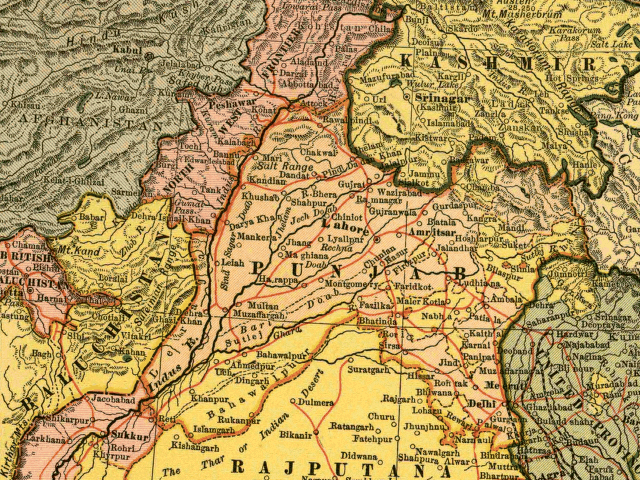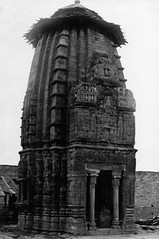 Not too high up the foothills of the Himalayas, not too far from Dalhousie, that beloved film-spot of sundry Hindi films, a traveller in search of beauty will find the little old town of Chamba. 926 metres above sea-level and along the banks of the river Ravi nestles the old city of the Varman kings. Founded sometime in the 10th century, the little kingdom lasted in various guises for almost a thousand years, and at the time of the Raj was a recognised Princely State. In its heyday, it was the centre of a dynamic culture of high art and architecture, the acme of which is the lovely temple complex that has survived to this day.
Not too high up the foothills of the Himalayas, not too far from Dalhousie, that beloved film-spot of sundry Hindi films, a traveller in search of beauty will find the little old town of Chamba. 926 metres above sea-level and along the banks of the river Ravi nestles the old city of the Varman kings. Founded sometime in the 10th century, the little kingdom lasted in various guises for almost a thousand years, and at the time of the Raj was a recognised Princely State. In its heyday, it was the centre of a dynamic culture of high art and architecture, the acme of which is the lovely temple complex that has survived to this day.

The intricately wrought temples in the region are reminiscent of the craft of the Gupta period, and this is not surprising. Throughout the north of India flowed ideas and techniques informing the art and architecture of Ellora and Aurangabad and Bilaspur and Sirpur. It is conjectured that itinerant sthapatis roved from town to town, sharing their knowledge and constructing temples in a singular mode. Of course, the great school of sculptors in Chamba developed their own style, blending influences from these sthapatis and from Kashmir. It is sufficiently distinctive that it can be given a name of its own - Pahari, i.e., of the mountains. [Photo upload by richardasplen, originally taken circa 1890]
 The complex named after its most famous temple, Lakshmi Narayan, was founded some time in the 14th century. [Photo by albert_8.] The turrets, shikharas, of the temples, six in number, are arranged along a straight line of sight from the entrance. These are dedicated to Lakshmi Damodara, Triyambakeswara, Gauri Shankara, Chandragupta Mahadeva, Radha Krishna, and the eponymous temple at the farthest end. Three in honour of Vishnu, and three redounding to devotion to Shiva. Characteristic to all structures here is the sedge-hat wooden roof, an indigenous design developed to protect the temples, given the easy availability of wood. Every wall surface is decorated with deities and panels, carved with mythological scenes. 1
The complex named after its most famous temple, Lakshmi Narayan, was founded some time in the 14th century. [Photo by albert_8.] The turrets, shikharas, of the temples, six in number, are arranged along a straight line of sight from the entrance. These are dedicated to Lakshmi Damodara, Triyambakeswara, Gauri Shankara, Chandragupta Mahadeva, Radha Krishna, and the eponymous temple at the farthest end. Three in honour of Vishnu, and three redounding to devotion to Shiva. Characteristic to all structures here is the sedge-hat wooden roof, an indigenous design developed to protect the temples, given the easy availability of wood. Every wall surface is decorated with deities and panels, carved with mythological scenes. 1

It is said 2 that the marble for the Lakshmi-Narayan complex was brought from the Vindhyas by Yogakaravarman, the son of Sahillavarman who founded the city. The principal shrine is the tallest structure in the complex; at the other end, Lakshmi Damodara is opposed by a delightfully metal-wrought sculpture of Garuda facing his Lord from atop a column. While the original temples were all in stone, a century or so after their construction, the wooded mandapas were added to the Lakshmi-Narayan. [Photo upload by richardasplen, originally taken circa 1890]
Invariably, the tall curvilinear spires are crowned by a ribbed capstone, termed amalaka. The finials are then embellished with decorative motifs. Notable is the placement of fine deities facing in each direction. The curvaceous female divinities on the niches and walls of the temples evoke graceful postures from classical dance, which are also mirrored in the intricate carving of vines and flowers.
Subtle is the craftsman's hand, indeed.
References
1. Takeo Kamiya, The Guide to the Architecture of the Indian Subcontinent, Architecture Anonymous, 2004. Delhi.
2. (ed.) Mulk Raj Anand, Splendours of Himachal Heritage, Abhinav Publications, 1997. Delhi.

0 comments:
Post a Comment